Tourism Industry Reforms in Australia: A Comprehensive Analysis
VerifiedAdded on 2024/06/03
|10
|3195
|139
AI Summary
This study delves into the significant role of tourism in Australia's economic growth, examining the impact of industry reforms on the sector's performance. It analyzes the contribution of tourism to GDP, employment trends, and the influence of government policies, including fiscal strategies and the National Broadband Network (NBN), on the industry's development. The study highlights the challenges and opportunities facing the tourism sector in Australia, providing insights into the evolving dynamics of this vital industry.
Contribute Materials
Your contribution can guide someone’s learning journey. Share your
documents today.
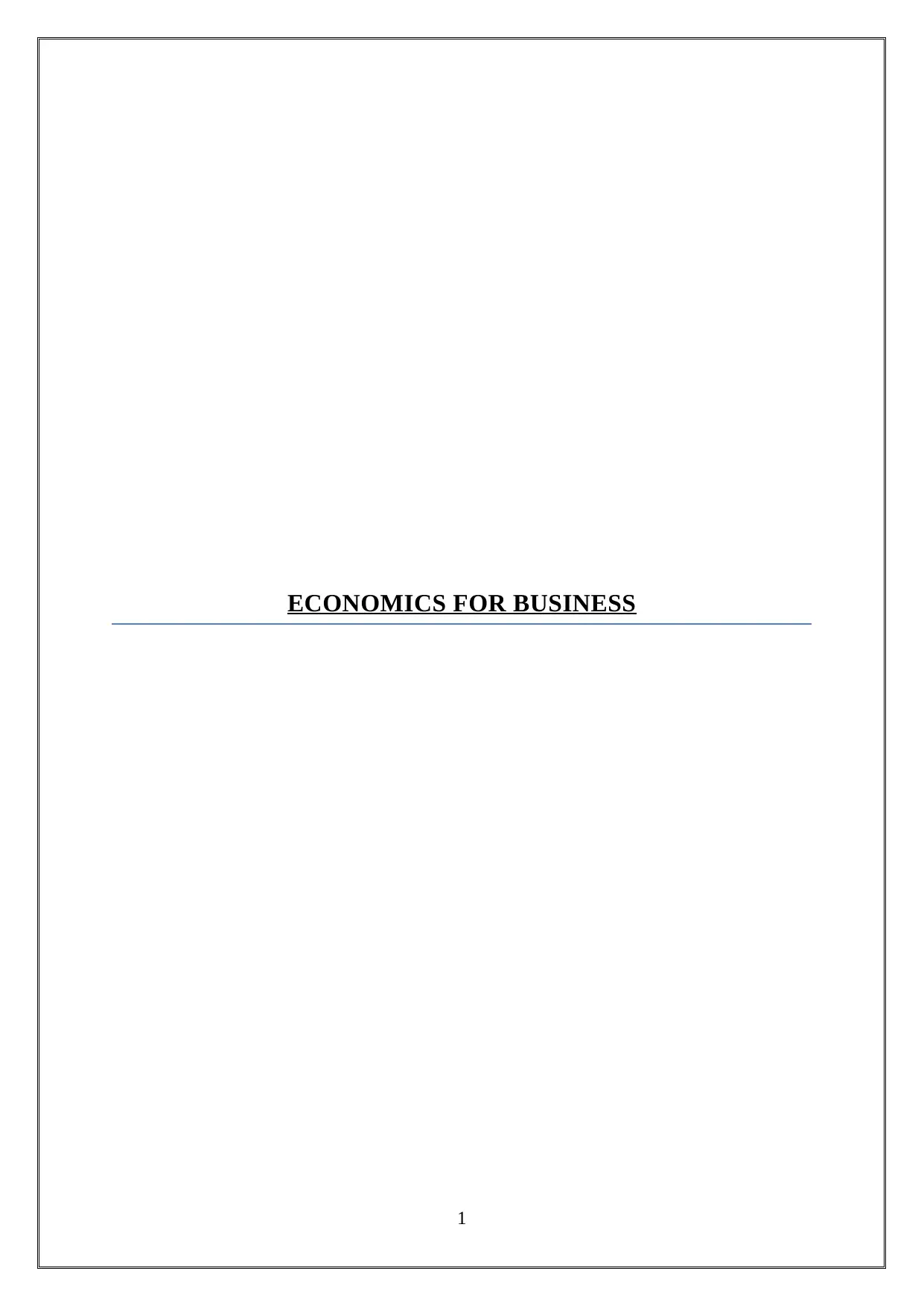
ECONOMICS FOR BUSINESS
1
1
Secure Best Marks with AI Grader
Need help grading? Try our AI Grader for instant feedback on your assignments.
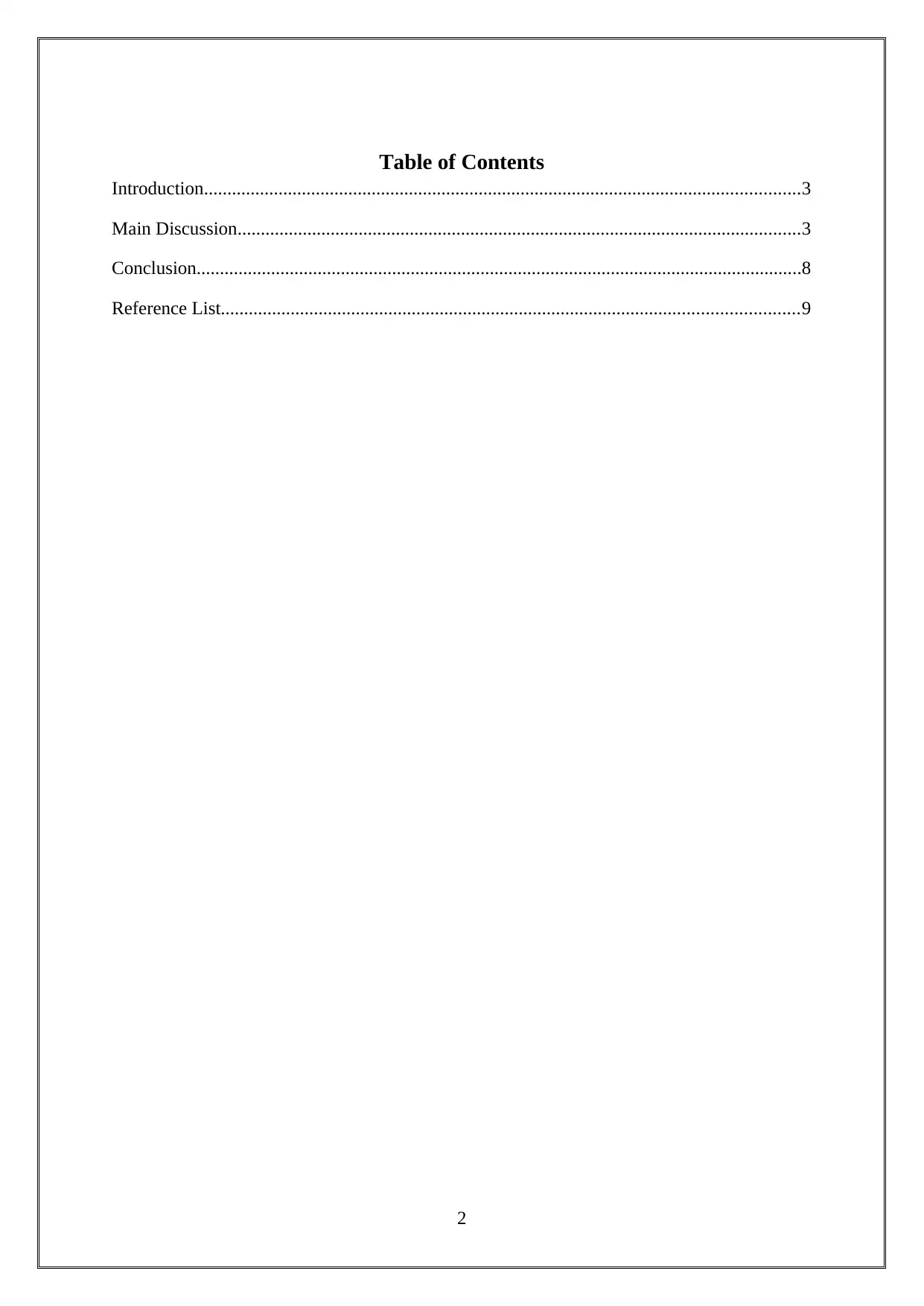
Table of Contents
Introduction................................................................................................................................3
Main Discussion.........................................................................................................................3
Conclusion..................................................................................................................................8
Reference List............................................................................................................................9
2
Introduction................................................................................................................................3
Main Discussion.........................................................................................................................3
Conclusion..................................................................................................................................8
Reference List............................................................................................................................9
2
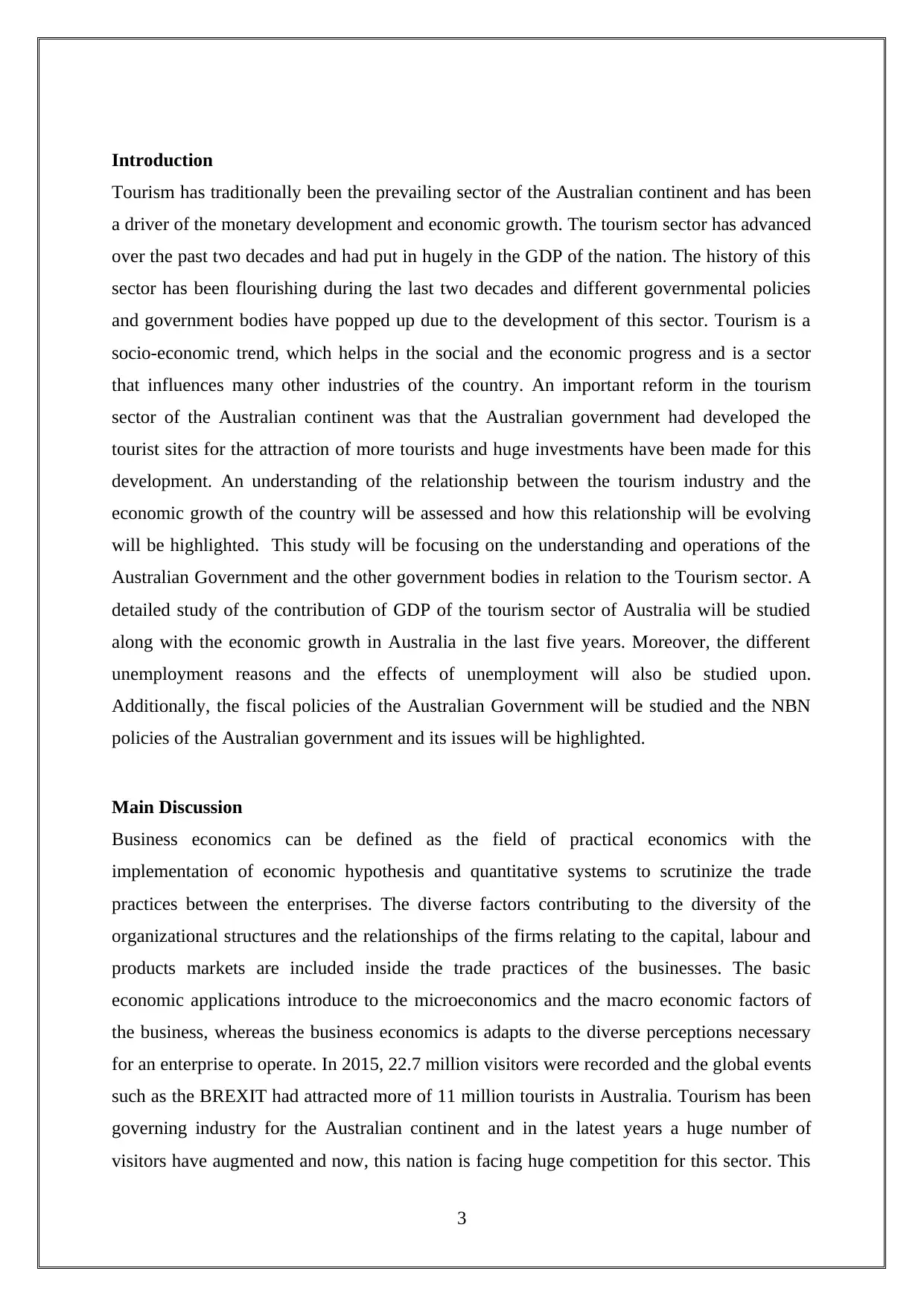
Introduction
Tourism has traditionally been the prevailing sector of the Australian continent and has been
a driver of the monetary development and economic growth. The tourism sector has advanced
over the past two decades and had put in hugely in the GDP of the nation. The history of this
sector has been flourishing during the last two decades and different governmental policies
and government bodies have popped up due to the development of this sector. Tourism is a
socio-economic trend, which helps in the social and the economic progress and is a sector
that influences many other industries of the country. An important reform in the tourism
sector of the Australian continent was that the Australian government had developed the
tourist sites for the attraction of more tourists and huge investments have been made for this
development. An understanding of the relationship between the tourism industry and the
economic growth of the country will be assessed and how this relationship will be evolving
will be highlighted. This study will be focusing on the understanding and operations of the
Australian Government and the other government bodies in relation to the Tourism sector. A
detailed study of the contribution of GDP of the tourism sector of Australia will be studied
along with the economic growth in Australia in the last five years. Moreover, the different
unemployment reasons and the effects of unemployment will also be studied upon.
Additionally, the fiscal policies of the Australian Government will be studied and the NBN
policies of the Australian government and its issues will be highlighted.
Main Discussion
Business economics can be defined as the field of practical economics with the
implementation of economic hypothesis and quantitative systems to scrutinize the trade
practices between the enterprises. The diverse factors contributing to the diversity of the
organizational structures and the relationships of the firms relating to the capital, labour and
products markets are included inside the trade practices of the businesses. The basic
economic applications introduce to the microeconomics and the macro economic factors of
the business, whereas the business economics is adapts to the diverse perceptions necessary
for an enterprise to operate. In 2015, 22.7 million visitors were recorded and the global events
such as the BREXIT had attracted more of 11 million tourists in Australia. Tourism has been
governing industry for the Australian continent and in the latest years a huge number of
visitors have augmented and now, this nation is facing huge competition for this sector. This
3
Tourism has traditionally been the prevailing sector of the Australian continent and has been
a driver of the monetary development and economic growth. The tourism sector has advanced
over the past two decades and had put in hugely in the GDP of the nation. The history of this
sector has been flourishing during the last two decades and different governmental policies
and government bodies have popped up due to the development of this sector. Tourism is a
socio-economic trend, which helps in the social and the economic progress and is a sector
that influences many other industries of the country. An important reform in the tourism
sector of the Australian continent was that the Australian government had developed the
tourist sites for the attraction of more tourists and huge investments have been made for this
development. An understanding of the relationship between the tourism industry and the
economic growth of the country will be assessed and how this relationship will be evolving
will be highlighted. This study will be focusing on the understanding and operations of the
Australian Government and the other government bodies in relation to the Tourism sector. A
detailed study of the contribution of GDP of the tourism sector of Australia will be studied
along with the economic growth in Australia in the last five years. Moreover, the different
unemployment reasons and the effects of unemployment will also be studied upon.
Additionally, the fiscal policies of the Australian Government will be studied and the NBN
policies of the Australian government and its issues will be highlighted.
Main Discussion
Business economics can be defined as the field of practical economics with the
implementation of economic hypothesis and quantitative systems to scrutinize the trade
practices between the enterprises. The diverse factors contributing to the diversity of the
organizational structures and the relationships of the firms relating to the capital, labour and
products markets are included inside the trade practices of the businesses. The basic
economic applications introduce to the microeconomics and the macro economic factors of
the business, whereas the business economics is adapts to the diverse perceptions necessary
for an enterprise to operate. In 2015, 22.7 million visitors were recorded and the global events
such as the BREXIT had attracted more of 11 million tourists in Australia. Tourism has been
governing industry for the Australian continent and in the latest years a huge number of
visitors have augmented and now, this nation is facing huge competition for this sector. This
3
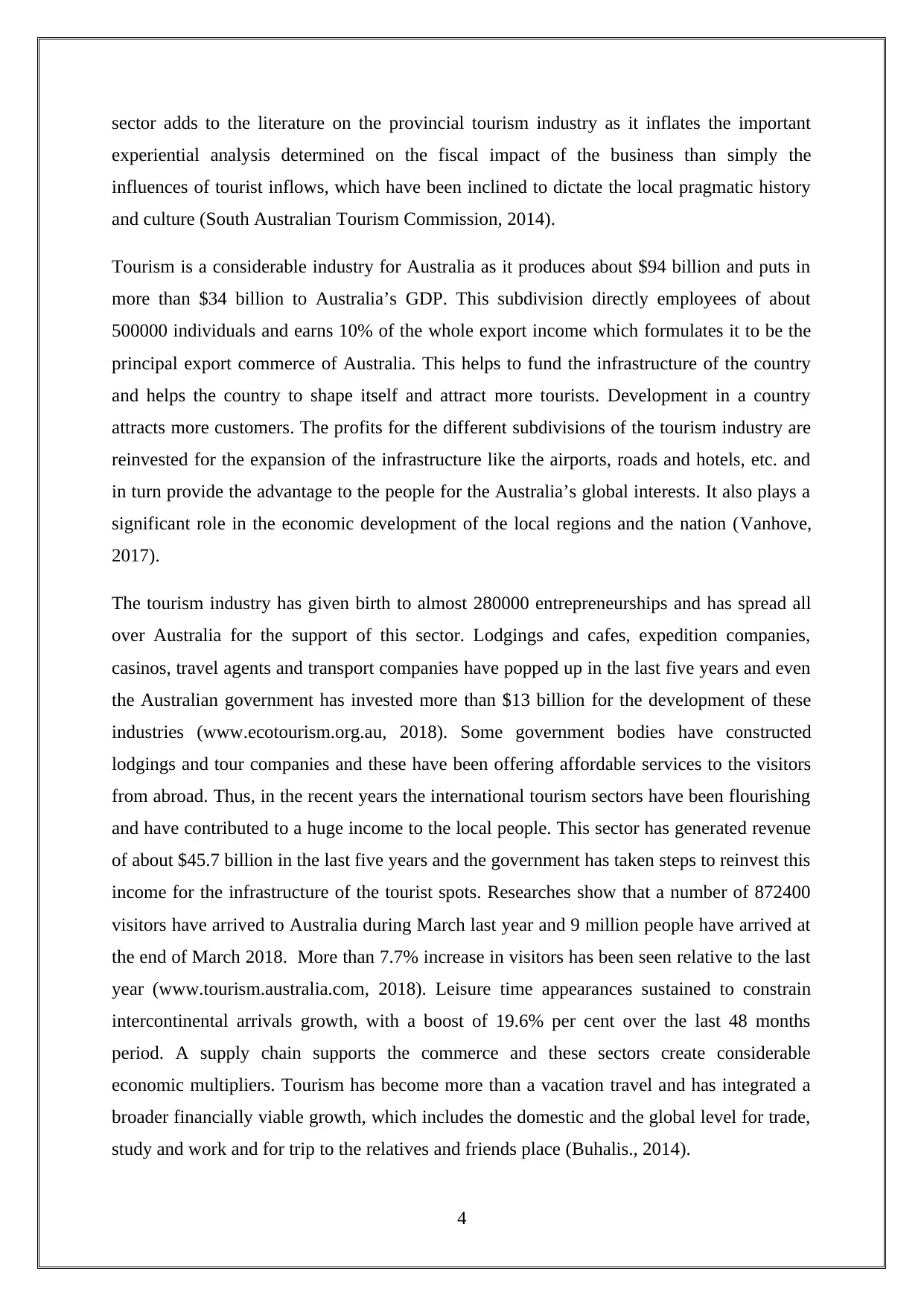
sector adds to the literature on the provincial tourism industry as it inflates the important
experiential analysis determined on the fiscal impact of the business than simply the
influences of tourist inflows, which have been inclined to dictate the local pragmatic history
and culture (South Australian Tourism Commission, 2014).
Tourism is a considerable industry for Australia as it produces about $94 billion and puts in
more than $34 billion to Australia’s GDP. This subdivision directly employees of about
500000 individuals and earns 10% of the whole export income which formulates it to be the
principal export commerce of Australia. This helps to fund the infrastructure of the country
and helps the country to shape itself and attract more tourists. Development in a country
attracts more customers. The profits for the different subdivisions of the tourism industry are
reinvested for the expansion of the infrastructure like the airports, roads and hotels, etc. and
in turn provide the advantage to the people for the Australia’s global interests. It also plays a
significant role in the economic development of the local regions and the nation (Vanhove,
2017).
The tourism industry has given birth to almost 280000 entrepreneurships and has spread all
over Australia for the support of this sector. Lodgings and cafes, expedition companies,
casinos, travel agents and transport companies have popped up in the last five years and even
the Australian government has invested more than $13 billion for the development of these
industries (www.ecotourism.org.au, 2018). Some government bodies have constructed
lodgings and tour companies and these have been offering affordable services to the visitors
from abroad. Thus, in the recent years the international tourism sectors have been flourishing
and have contributed to a huge income to the local people. This sector has generated revenue
of about $45.7 billion in the last five years and the government has taken steps to reinvest this
income for the infrastructure of the tourist spots. Researches show that a number of 872400
visitors have arrived to Australia during March last year and 9 million people have arrived at
the end of March 2018. More than 7.7% increase in visitors has been seen relative to the last
year (www.tourism.australia.com, 2018). Leisure time appearances sustained to constrain
intercontinental arrivals growth, with a boost of 19.6% per cent over the last 48 months
period. A supply chain supports the commerce and these sectors create considerable
economic multipliers. Tourism has become more than a vacation travel and has integrated a
broader financially viable growth, which includes the domestic and the global level for trade,
study and work and for trip to the relatives and friends place (Buhalis., 2014).
4
experiential analysis determined on the fiscal impact of the business than simply the
influences of tourist inflows, which have been inclined to dictate the local pragmatic history
and culture (South Australian Tourism Commission, 2014).
Tourism is a considerable industry for Australia as it produces about $94 billion and puts in
more than $34 billion to Australia’s GDP. This subdivision directly employees of about
500000 individuals and earns 10% of the whole export income which formulates it to be the
principal export commerce of Australia. This helps to fund the infrastructure of the country
and helps the country to shape itself and attract more tourists. Development in a country
attracts more customers. The profits for the different subdivisions of the tourism industry are
reinvested for the expansion of the infrastructure like the airports, roads and hotels, etc. and
in turn provide the advantage to the people for the Australia’s global interests. It also plays a
significant role in the economic development of the local regions and the nation (Vanhove,
2017).
The tourism industry has given birth to almost 280000 entrepreneurships and has spread all
over Australia for the support of this sector. Lodgings and cafes, expedition companies,
casinos, travel agents and transport companies have popped up in the last five years and even
the Australian government has invested more than $13 billion for the development of these
industries (www.ecotourism.org.au, 2018). Some government bodies have constructed
lodgings and tour companies and these have been offering affordable services to the visitors
from abroad. Thus, in the recent years the international tourism sectors have been flourishing
and have contributed to a huge income to the local people. This sector has generated revenue
of about $45.7 billion in the last five years and the government has taken steps to reinvest this
income for the infrastructure of the tourist spots. Researches show that a number of 872400
visitors have arrived to Australia during March last year and 9 million people have arrived at
the end of March 2018. More than 7.7% increase in visitors has been seen relative to the last
year (www.tourism.australia.com, 2018). Leisure time appearances sustained to constrain
intercontinental arrivals growth, with a boost of 19.6% per cent over the last 48 months
period. A supply chain supports the commerce and these sectors create considerable
economic multipliers. Tourism has become more than a vacation travel and has integrated a
broader financially viable growth, which includes the domestic and the global level for trade,
study and work and for trip to the relatives and friends place (Buhalis., 2014).
4
Secure Best Marks with AI Grader
Need help grading? Try our AI Grader for instant feedback on your assignments.
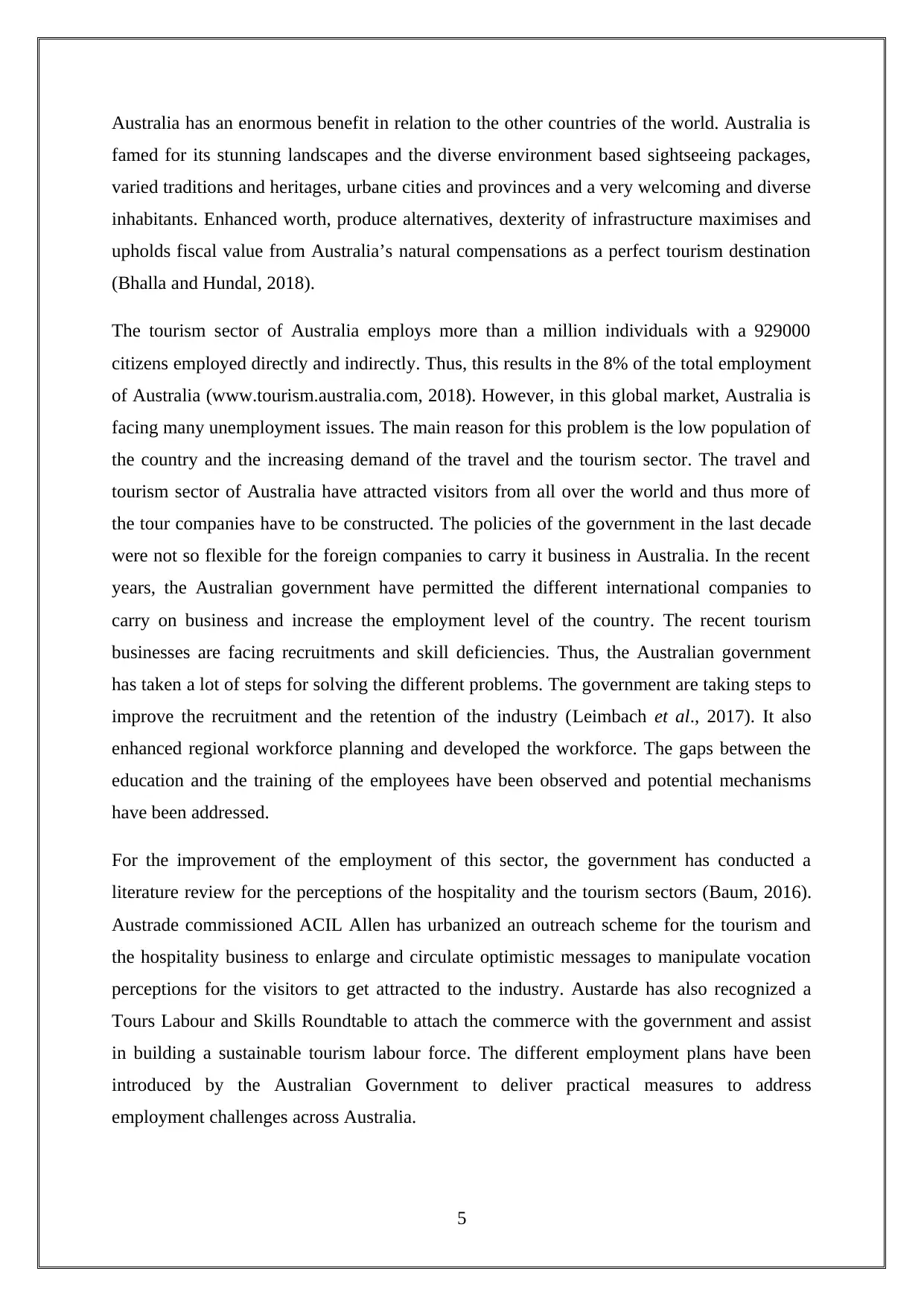
Australia has an enormous benefit in relation to the other countries of the world. Australia is
famed for its stunning landscapes and the diverse environment based sightseeing packages,
varied traditions and heritages, urbane cities and provinces and a very welcoming and diverse
inhabitants. Enhanced worth, produce alternatives, dexterity of infrastructure maximises and
upholds fiscal value from Australia’s natural compensations as a perfect tourism destination
(Bhalla and Hundal, 2018).
The tourism sector of Australia employs more than a million individuals with a 929000
citizens employed directly and indirectly. Thus, this results in the 8% of the total employment
of Australia (www.tourism.australia.com, 2018). However, in this global market, Australia is
facing many unemployment issues. The main reason for this problem is the low population of
the country and the increasing demand of the travel and the tourism sector. The travel and
tourism sector of Australia have attracted visitors from all over the world and thus more of
the tour companies have to be constructed. The policies of the government in the last decade
were not so flexible for the foreign companies to carry it business in Australia. In the recent
years, the Australian government have permitted the different international companies to
carry on business and increase the employment level of the country. The recent tourism
businesses are facing recruitments and skill deficiencies. Thus, the Australian government
has taken a lot of steps for solving the different problems. The government are taking steps to
improve the recruitment and the retention of the industry (Leimbach et al., 2017). It also
enhanced regional workforce planning and developed the workforce. The gaps between the
education and the training of the employees have been observed and potential mechanisms
have been addressed.
For the improvement of the employment of this sector, the government has conducted a
literature review for the perceptions of the hospitality and the tourism sectors (Baum, 2016).
Austrade commissioned ACIL Allen has urbanized an outreach scheme for the tourism and
the hospitality business to enlarge and circulate optimistic messages to manipulate vocation
perceptions for the visitors to get attracted to the industry. Austarde has also recognized a
Tours Labour and Skills Roundtable to attach the commerce with the government and assist
in building a sustainable tourism labour force. The different employment plans have been
introduced by the Australian Government to deliver practical measures to address
employment challenges across Australia.
5
famed for its stunning landscapes and the diverse environment based sightseeing packages,
varied traditions and heritages, urbane cities and provinces and a very welcoming and diverse
inhabitants. Enhanced worth, produce alternatives, dexterity of infrastructure maximises and
upholds fiscal value from Australia’s natural compensations as a perfect tourism destination
(Bhalla and Hundal, 2018).
The tourism sector of Australia employs more than a million individuals with a 929000
citizens employed directly and indirectly. Thus, this results in the 8% of the total employment
of Australia (www.tourism.australia.com, 2018). However, in this global market, Australia is
facing many unemployment issues. The main reason for this problem is the low population of
the country and the increasing demand of the travel and the tourism sector. The travel and
tourism sector of Australia have attracted visitors from all over the world and thus more of
the tour companies have to be constructed. The policies of the government in the last decade
were not so flexible for the foreign companies to carry it business in Australia. In the recent
years, the Australian government have permitted the different international companies to
carry on business and increase the employment level of the country. The recent tourism
businesses are facing recruitments and skill deficiencies. Thus, the Australian government
has taken a lot of steps for solving the different problems. The government are taking steps to
improve the recruitment and the retention of the industry (Leimbach et al., 2017). It also
enhanced regional workforce planning and developed the workforce. The gaps between the
education and the training of the employees have been observed and potential mechanisms
have been addressed.
For the improvement of the employment of this sector, the government has conducted a
literature review for the perceptions of the hospitality and the tourism sectors (Baum, 2016).
Austrade commissioned ACIL Allen has urbanized an outreach scheme for the tourism and
the hospitality business to enlarge and circulate optimistic messages to manipulate vocation
perceptions for the visitors to get attracted to the industry. Austarde has also recognized a
Tours Labour and Skills Roundtable to attach the commerce with the government and assist
in building a sustainable tourism labour force. The different employment plans have been
introduced by the Australian Government to deliver practical measures to address
employment challenges across Australia.
5
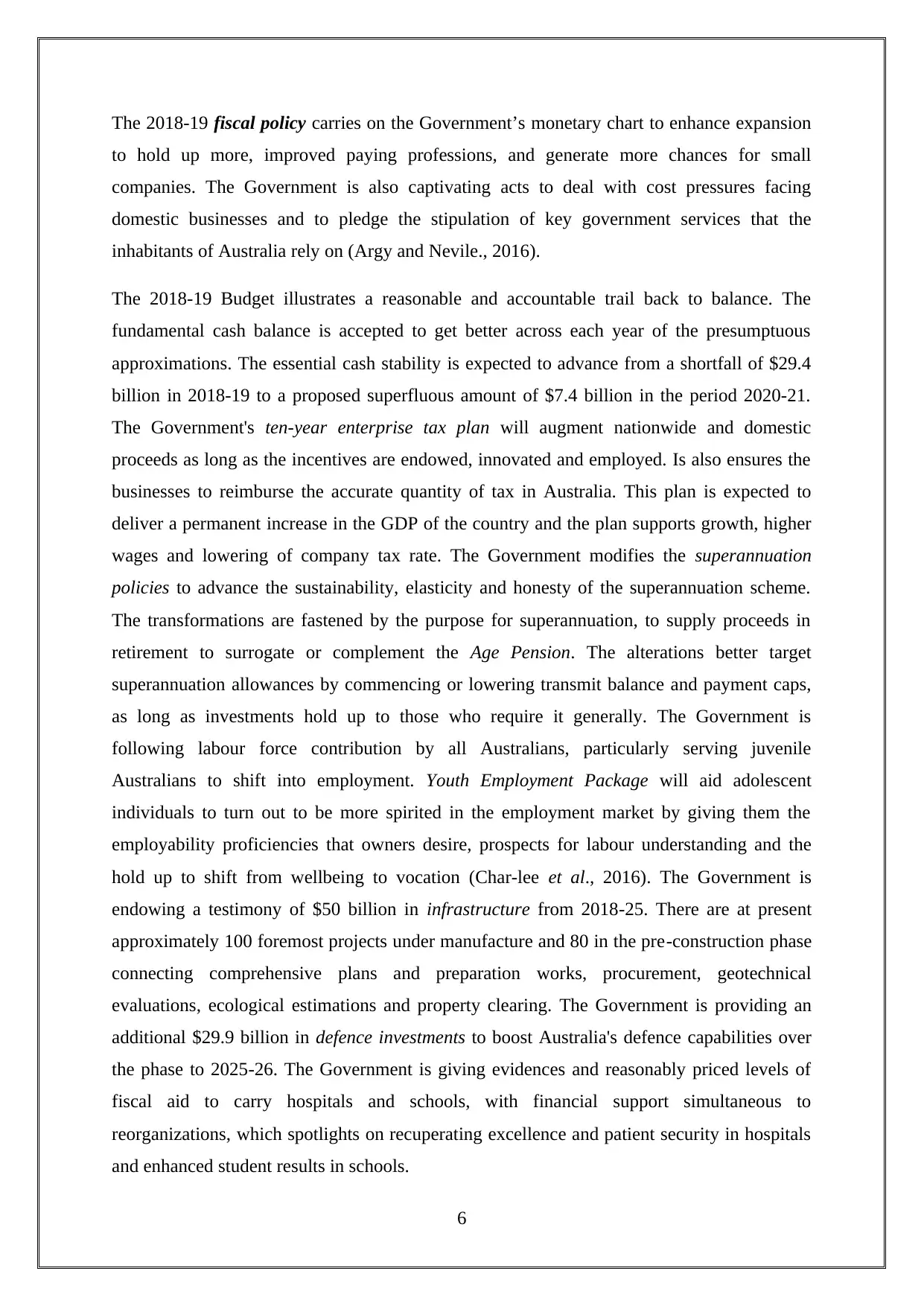
The 2018-19 fiscal policy carries on the Government’s monetary chart to enhance expansion
to hold up more, improved paying professions, and generate more chances for small
companies. The Government is also captivating acts to deal with cost pressures facing
domestic businesses and to pledge the stipulation of key government services that the
inhabitants of Australia rely on (Argy and Nevile., 2016).
The 2018-19 Budget illustrates a reasonable and accountable trail back to balance. The
fundamental cash balance is accepted to get better across each year of the presumptuous
approximations. The essential cash stability is expected to advance from a shortfall of $29.4
billion in 2018-19 to a proposed superfluous amount of $7.4 billion in the period 2020-21.
The Government's ten-year enterprise tax plan will augment nationwide and domestic
proceeds as long as the incentives are endowed, innovated and employed. Is also ensures the
businesses to reimburse the accurate quantity of tax in Australia. This plan is expected to
deliver a permanent increase in the GDP of the country and the plan supports growth, higher
wages and lowering of company tax rate. The Government modifies the superannuation
policies to advance the sustainability, elasticity and honesty of the superannuation scheme.
The transformations are fastened by the purpose for superannuation, to supply proceeds in
retirement to surrogate or complement the Age Pension. The alterations better target
superannuation allowances by commencing or lowering transmit balance and payment caps,
as long as investments hold up to those who require it generally. The Government is
following labour force contribution by all Australians, particularly serving juvenile
Australians to shift into employment. Youth Employment Package will aid adolescent
individuals to turn out to be more spirited in the employment market by giving them the
employability proficiencies that owners desire, prospects for labour understanding and the
hold up to shift from wellbeing to vocation (Char-lee et al., 2016). The Government is
endowing a testimony of $50 billion in infrastructure from 2018-25. There are at present
approximately 100 foremost projects under manufacture and 80 in the pre-construction phase
connecting comprehensive plans and preparation works, procurement, geotechnical
evaluations, ecological estimations and property clearing. The Government is providing an
additional $29.9 billion in defence investments to boost Australia's defence capabilities over
the phase to 2025-26. The Government is giving evidences and reasonably priced levels of
fiscal aid to carry hospitals and schools, with financial support simultaneous to
reorganizations, which spotlights on recuperating excellence and patient security in hospitals
and enhanced student results in schools.
6
to hold up more, improved paying professions, and generate more chances for small
companies. The Government is also captivating acts to deal with cost pressures facing
domestic businesses and to pledge the stipulation of key government services that the
inhabitants of Australia rely on (Argy and Nevile., 2016).
The 2018-19 Budget illustrates a reasonable and accountable trail back to balance. The
fundamental cash balance is accepted to get better across each year of the presumptuous
approximations. The essential cash stability is expected to advance from a shortfall of $29.4
billion in 2018-19 to a proposed superfluous amount of $7.4 billion in the period 2020-21.
The Government's ten-year enterprise tax plan will augment nationwide and domestic
proceeds as long as the incentives are endowed, innovated and employed. Is also ensures the
businesses to reimburse the accurate quantity of tax in Australia. This plan is expected to
deliver a permanent increase in the GDP of the country and the plan supports growth, higher
wages and lowering of company tax rate. The Government modifies the superannuation
policies to advance the sustainability, elasticity and honesty of the superannuation scheme.
The transformations are fastened by the purpose for superannuation, to supply proceeds in
retirement to surrogate or complement the Age Pension. The alterations better target
superannuation allowances by commencing or lowering transmit balance and payment caps,
as long as investments hold up to those who require it generally. The Government is
following labour force contribution by all Australians, particularly serving juvenile
Australians to shift into employment. Youth Employment Package will aid adolescent
individuals to turn out to be more spirited in the employment market by giving them the
employability proficiencies that owners desire, prospects for labour understanding and the
hold up to shift from wellbeing to vocation (Char-lee et al., 2016). The Government is
endowing a testimony of $50 billion in infrastructure from 2018-25. There are at present
approximately 100 foremost projects under manufacture and 80 in the pre-construction phase
connecting comprehensive plans and preparation works, procurement, geotechnical
evaluations, ecological estimations and property clearing. The Government is providing an
additional $29.9 billion in defence investments to boost Australia's defence capabilities over
the phase to 2025-26. The Government is giving evidences and reasonably priced levels of
fiscal aid to carry hospitals and schools, with financial support simultaneous to
reorganizations, which spotlights on recuperating excellence and patient security in hospitals
and enhanced student results in schools.
6
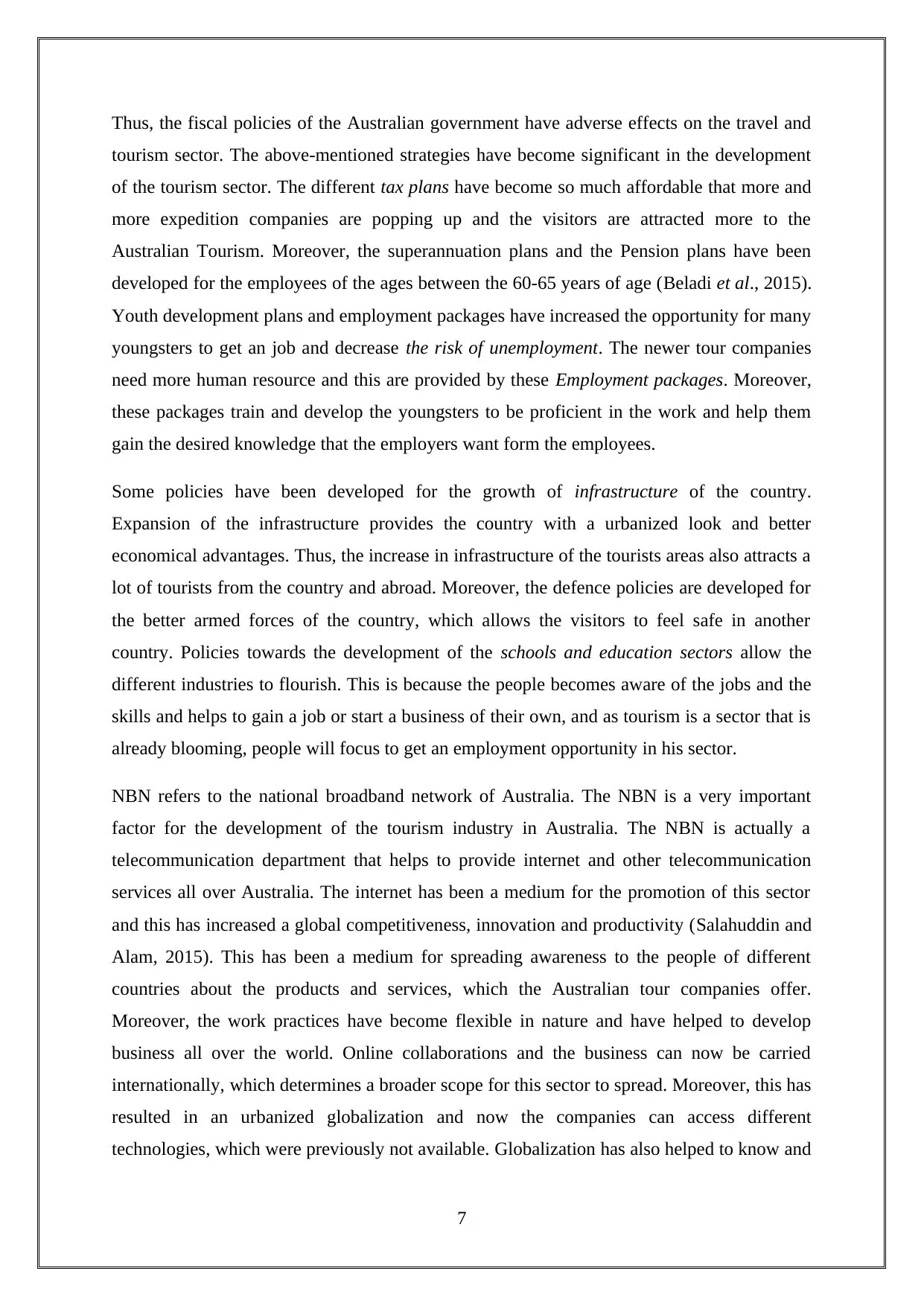
Thus, the fiscal policies of the Australian government have adverse effects on the travel and
tourism sector. The above-mentioned strategies have become significant in the development
of the tourism sector. The different tax plans have become so much affordable that more and
more expedition companies are popping up and the visitors are attracted more to the
Australian Tourism. Moreover, the superannuation plans and the Pension plans have been
developed for the employees of the ages between the 60-65 years of age (Beladi et al., 2015).
Youth development plans and employment packages have increased the opportunity for many
youngsters to get an job and decrease the risk of unemployment. The newer tour companies
need more human resource and this are provided by these Employment packages. Moreover,
these packages train and develop the youngsters to be proficient in the work and help them
gain the desired knowledge that the employers want form the employees.
Some policies have been developed for the growth of infrastructure of the country.
Expansion of the infrastructure provides the country with a urbanized look and better
economical advantages. Thus, the increase in infrastructure of the tourists areas also attracts a
lot of tourists from the country and abroad. Moreover, the defence policies are developed for
the better armed forces of the country, which allows the visitors to feel safe in another
country. Policies towards the development of the schools and education sectors allow the
different industries to flourish. This is because the people becomes aware of the jobs and the
skills and helps to gain a job or start a business of their own, and as tourism is a sector that is
already blooming, people will focus to get an employment opportunity in his sector.
NBN refers to the national broadband network of Australia. The NBN is a very important
factor for the development of the tourism industry in Australia. The NBN is actually a
telecommunication department that helps to provide internet and other telecommunication
services all over Australia. The internet has been a medium for the promotion of this sector
and this has increased a global competitiveness, innovation and productivity (Salahuddin and
Alam, 2015). This has been a medium for spreading awareness to the people of different
countries about the products and services, which the Australian tour companies offer.
Moreover, the work practices have become flexible in nature and have helped to develop
business all over the world. Online collaborations and the business can now be carried
internationally, which determines a broader scope for this sector to spread. Moreover, this has
resulted in an urbanized globalization and now the companies can access different
technologies, which were previously not available. Globalization has also helped to know and
7
tourism sector. The above-mentioned strategies have become significant in the development
of the tourism sector. The different tax plans have become so much affordable that more and
more expedition companies are popping up and the visitors are attracted more to the
Australian Tourism. Moreover, the superannuation plans and the Pension plans have been
developed for the employees of the ages between the 60-65 years of age (Beladi et al., 2015).
Youth development plans and employment packages have increased the opportunity for many
youngsters to get an job and decrease the risk of unemployment. The newer tour companies
need more human resource and this are provided by these Employment packages. Moreover,
these packages train and develop the youngsters to be proficient in the work and help them
gain the desired knowledge that the employers want form the employees.
Some policies have been developed for the growth of infrastructure of the country.
Expansion of the infrastructure provides the country with a urbanized look and better
economical advantages. Thus, the increase in infrastructure of the tourists areas also attracts a
lot of tourists from the country and abroad. Moreover, the defence policies are developed for
the better armed forces of the country, which allows the visitors to feel safe in another
country. Policies towards the development of the schools and education sectors allow the
different industries to flourish. This is because the people becomes aware of the jobs and the
skills and helps to gain a job or start a business of their own, and as tourism is a sector that is
already blooming, people will focus to get an employment opportunity in his sector.
NBN refers to the national broadband network of Australia. The NBN is a very important
factor for the development of the tourism industry in Australia. The NBN is actually a
telecommunication department that helps to provide internet and other telecommunication
services all over Australia. The internet has been a medium for the promotion of this sector
and this has increased a global competitiveness, innovation and productivity (Salahuddin and
Alam, 2015). This has been a medium for spreading awareness to the people of different
countries about the products and services, which the Australian tour companies offer.
Moreover, the work practices have become flexible in nature and have helped to develop
business all over the world. Online collaborations and the business can now be carried
internationally, which determines a broader scope for this sector to spread. Moreover, this has
resulted in an urbanized globalization and now the companies can access different
technologies, which were previously not available. Globalization has also helped to know and
7
Paraphrase This Document
Need a fresh take? Get an instant paraphrase of this document with our AI Paraphraser
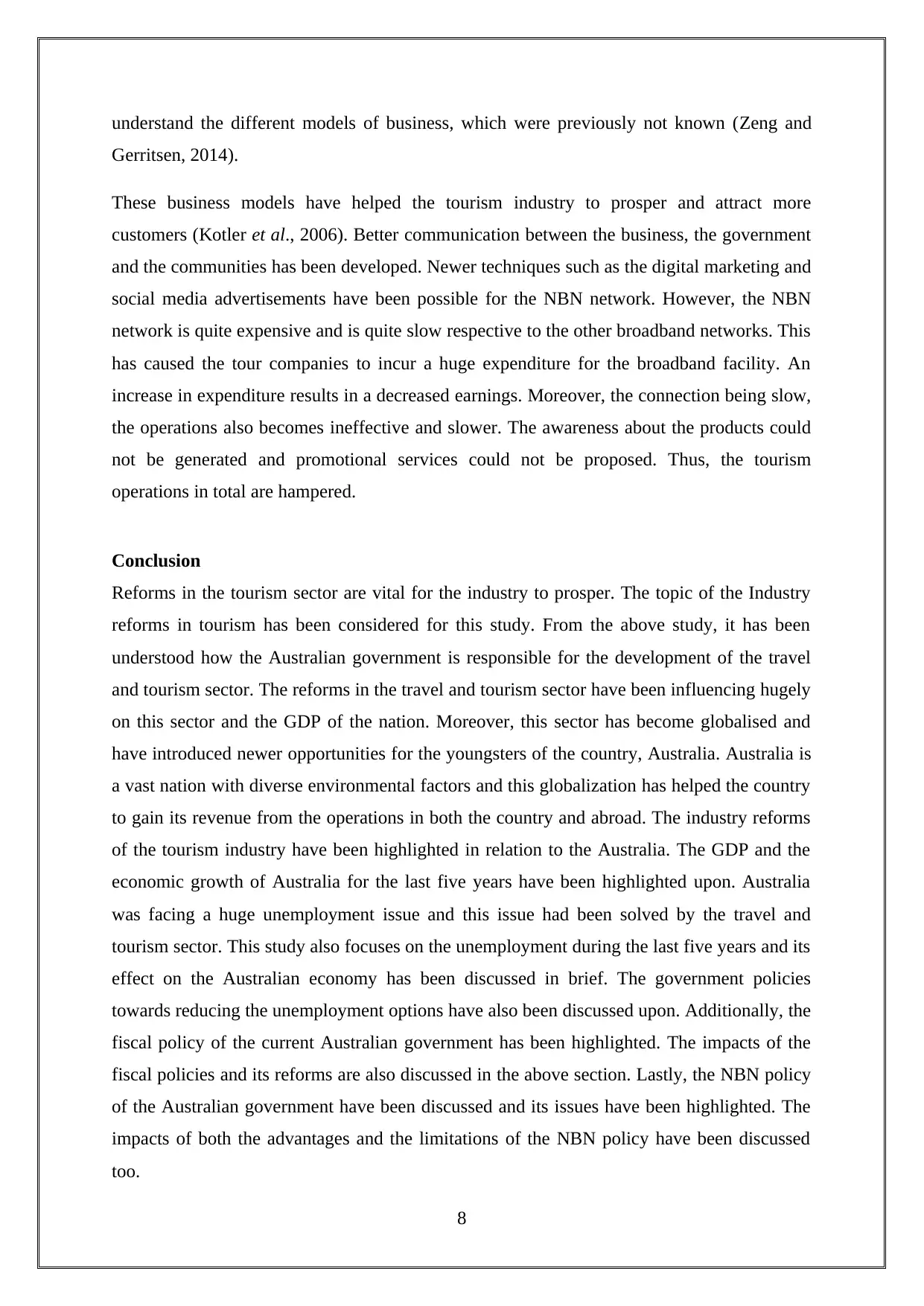
understand the different models of business, which were previously not known (Zeng and
Gerritsen, 2014).
These business models have helped the tourism industry to prosper and attract more
customers (Kotler et al., 2006). Better communication between the business, the government
and the communities has been developed. Newer techniques such as the digital marketing and
social media advertisements have been possible for the NBN network. However, the NBN
network is quite expensive and is quite slow respective to the other broadband networks. This
has caused the tour companies to incur a huge expenditure for the broadband facility. An
increase in expenditure results in a decreased earnings. Moreover, the connection being slow,
the operations also becomes ineffective and slower. The awareness about the products could
not be generated and promotional services could not be proposed. Thus, the tourism
operations in total are hampered.
Conclusion
Reforms in the tourism sector are vital for the industry to prosper. The topic of the Industry
reforms in tourism has been considered for this study. From the above study, it has been
understood how the Australian government is responsible for the development of the travel
and tourism sector. The reforms in the travel and tourism sector have been influencing hugely
on this sector and the GDP of the nation. Moreover, this sector has become globalised and
have introduced newer opportunities for the youngsters of the country, Australia. Australia is
a vast nation with diverse environmental factors and this globalization has helped the country
to gain its revenue from the operations in both the country and abroad. The industry reforms
of the tourism industry have been highlighted in relation to the Australia. The GDP and the
economic growth of Australia for the last five years have been highlighted upon. Australia
was facing a huge unemployment issue and this issue had been solved by the travel and
tourism sector. This study also focuses on the unemployment during the last five years and its
effect on the Australian economy has been discussed in brief. The government policies
towards reducing the unemployment options have also been discussed upon. Additionally, the
fiscal policy of the current Australian government has been highlighted. The impacts of the
fiscal policies and its reforms are also discussed in the above section. Lastly, the NBN policy
of the Australian government have been discussed and its issues have been highlighted. The
impacts of both the advantages and the limitations of the NBN policy have been discussed
too.
8
Gerritsen, 2014).
These business models have helped the tourism industry to prosper and attract more
customers (Kotler et al., 2006). Better communication between the business, the government
and the communities has been developed. Newer techniques such as the digital marketing and
social media advertisements have been possible for the NBN network. However, the NBN
network is quite expensive and is quite slow respective to the other broadband networks. This
has caused the tour companies to incur a huge expenditure for the broadband facility. An
increase in expenditure results in a decreased earnings. Moreover, the connection being slow,
the operations also becomes ineffective and slower. The awareness about the products could
not be generated and promotional services could not be proposed. Thus, the tourism
operations in total are hampered.
Conclusion
Reforms in the tourism sector are vital for the industry to prosper. The topic of the Industry
reforms in tourism has been considered for this study. From the above study, it has been
understood how the Australian government is responsible for the development of the travel
and tourism sector. The reforms in the travel and tourism sector have been influencing hugely
on this sector and the GDP of the nation. Moreover, this sector has become globalised and
have introduced newer opportunities for the youngsters of the country, Australia. Australia is
a vast nation with diverse environmental factors and this globalization has helped the country
to gain its revenue from the operations in both the country and abroad. The industry reforms
of the tourism industry have been highlighted in relation to the Australia. The GDP and the
economic growth of Australia for the last five years have been highlighted upon. Australia
was facing a huge unemployment issue and this issue had been solved by the travel and
tourism sector. This study also focuses on the unemployment during the last five years and its
effect on the Australian economy has been discussed in brief. The government policies
towards reducing the unemployment options have also been discussed upon. Additionally, the
fiscal policy of the current Australian government has been highlighted. The impacts of the
fiscal policies and its reforms are also discussed in the above section. Lastly, the NBN policy
of the Australian government have been discussed and its issues have been highlighted. The
impacts of both the advantages and the limitations of the NBN policy have been discussed
too.
8
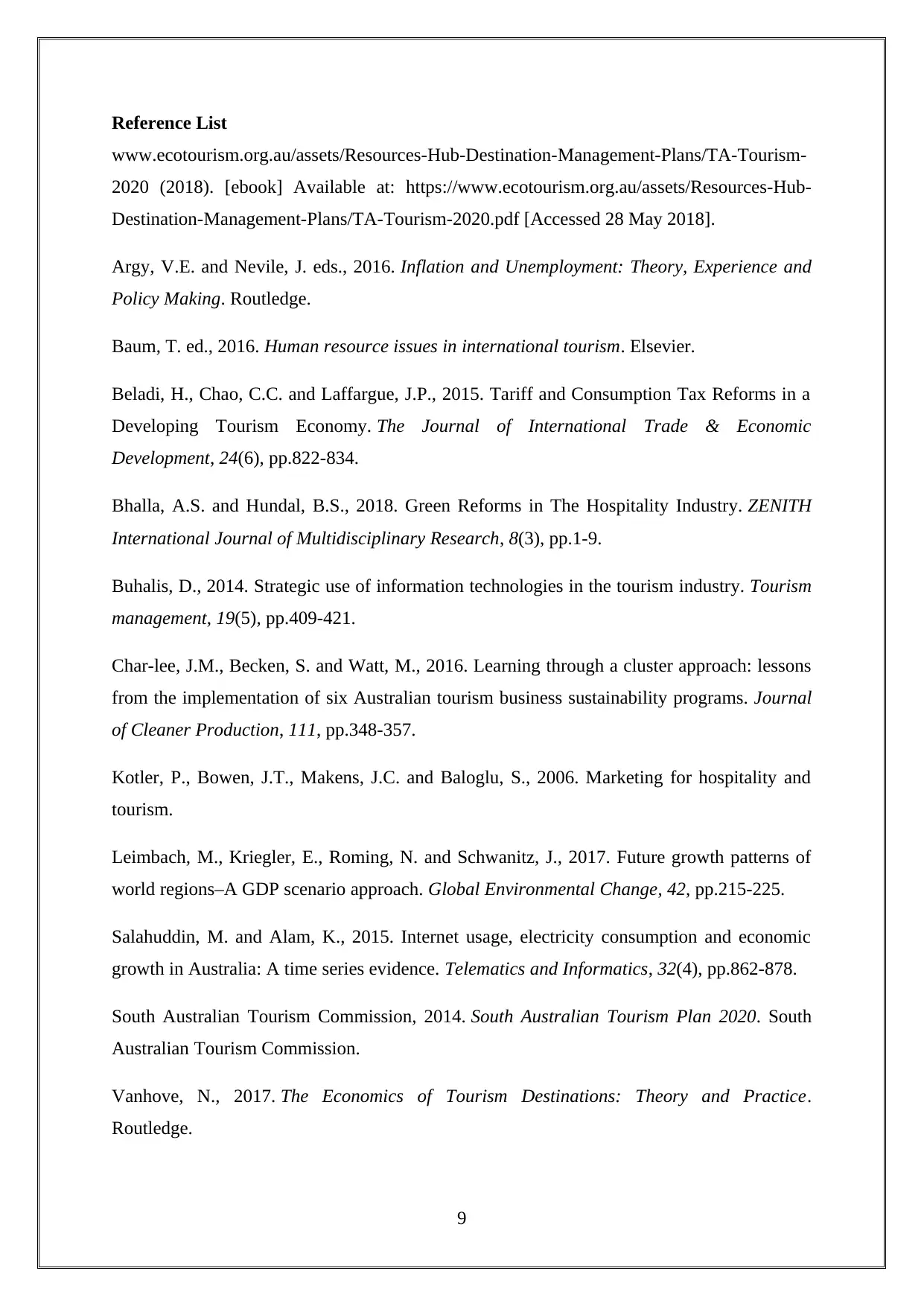
Reference List
www.ecotourism.org.au/assets/Resources-Hub-Destination-Management-Plans/TA-Tourism-
2020 (2018). [ebook] Available at: https://www.ecotourism.org.au/assets/Resources-Hub-
Destination-Management-Plans/TA-Tourism-2020.pdf [Accessed 28 May 2018].
Argy, V.E. and Nevile, J. eds., 2016. Inflation and Unemployment: Theory, Experience and
Policy Making. Routledge.
Baum, T. ed., 2016. Human resource issues in international tourism. Elsevier.
Beladi, H., Chao, C.C. and Laffargue, J.P., 2015. Tariff and Consumption Tax Reforms in a
Developing Tourism Economy. The Journal of International Trade & Economic
Development, 24(6), pp.822-834.
Bhalla, A.S. and Hundal, B.S., 2018. Green Reforms in The Hospitality Industry. ZENITH
International Journal of Multidisciplinary Research, 8(3), pp.1-9.
Buhalis, D., 2014. Strategic use of information technologies in the tourism industry. Tourism
management, 19(5), pp.409-421.
Char-lee, J.M., Becken, S. and Watt, M., 2016. Learning through a cluster approach: lessons
from the implementation of six Australian tourism business sustainability programs. Journal
of Cleaner Production, 111, pp.348-357.
Kotler, P., Bowen, J.T., Makens, J.C. and Baloglu, S., 2006. Marketing for hospitality and
tourism.
Leimbach, M., Kriegler, E., Roming, N. and Schwanitz, J., 2017. Future growth patterns of
world regions–A GDP scenario approach. Global Environmental Change, 42, pp.215-225.
Salahuddin, M. and Alam, K., 2015. Internet usage, electricity consumption and economic
growth in Australia: A time series evidence. Telematics and Informatics, 32(4), pp.862-878.
South Australian Tourism Commission, 2014. South Australian Tourism Plan 2020. South
Australian Tourism Commission.
Vanhove, N., 2017. The Economics of Tourism Destinations: Theory and Practice.
Routledge.
9
www.ecotourism.org.au/assets/Resources-Hub-Destination-Management-Plans/TA-Tourism-
2020 (2018). [ebook] Available at: https://www.ecotourism.org.au/assets/Resources-Hub-
Destination-Management-Plans/TA-Tourism-2020.pdf [Accessed 28 May 2018].
Argy, V.E. and Nevile, J. eds., 2016. Inflation and Unemployment: Theory, Experience and
Policy Making. Routledge.
Baum, T. ed., 2016. Human resource issues in international tourism. Elsevier.
Beladi, H., Chao, C.C. and Laffargue, J.P., 2015. Tariff and Consumption Tax Reforms in a
Developing Tourism Economy. The Journal of International Trade & Economic
Development, 24(6), pp.822-834.
Bhalla, A.S. and Hundal, B.S., 2018. Green Reforms in The Hospitality Industry. ZENITH
International Journal of Multidisciplinary Research, 8(3), pp.1-9.
Buhalis, D., 2014. Strategic use of information technologies in the tourism industry. Tourism
management, 19(5), pp.409-421.
Char-lee, J.M., Becken, S. and Watt, M., 2016. Learning through a cluster approach: lessons
from the implementation of six Australian tourism business sustainability programs. Journal
of Cleaner Production, 111, pp.348-357.
Kotler, P., Bowen, J.T., Makens, J.C. and Baloglu, S., 2006. Marketing for hospitality and
tourism.
Leimbach, M., Kriegler, E., Roming, N. and Schwanitz, J., 2017. Future growth patterns of
world regions–A GDP scenario approach. Global Environmental Change, 42, pp.215-225.
Salahuddin, M. and Alam, K., 2015. Internet usage, electricity consumption and economic
growth in Australia: A time series evidence. Telematics and Informatics, 32(4), pp.862-878.
South Australian Tourism Commission, 2014. South Australian Tourism Plan 2020. South
Australian Tourism Commission.
Vanhove, N., 2017. The Economics of Tourism Destinations: Theory and Practice.
Routledge.
9
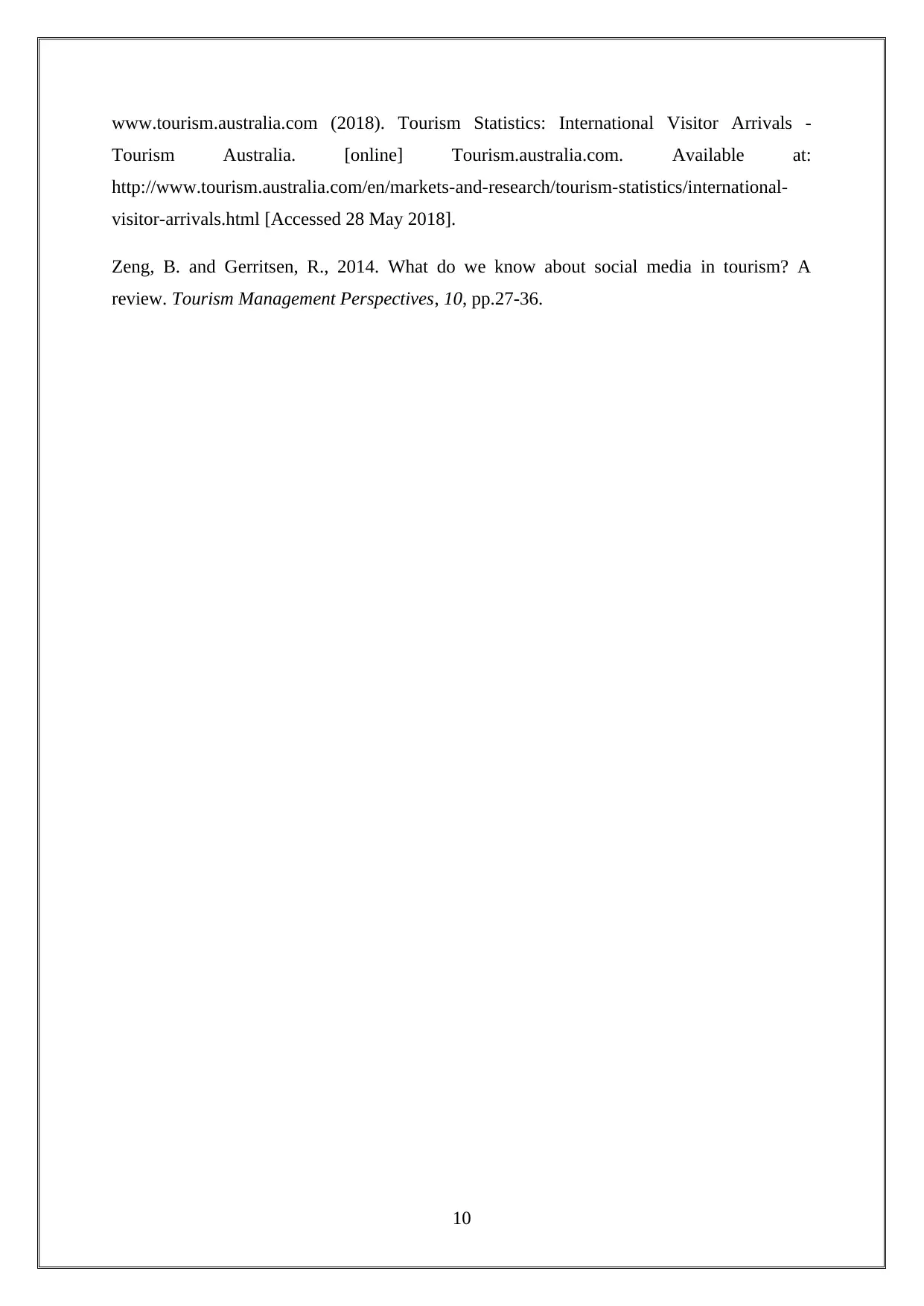
www.tourism.australia.com (2018). Tourism Statistics: International Visitor Arrivals -
Tourism Australia. [online] Tourism.australia.com. Available at:
http://www.tourism.australia.com/en/markets-and-research/tourism-statistics/international-
visitor-arrivals.html [Accessed 28 May 2018].
Zeng, B. and Gerritsen, R., 2014. What do we know about social media in tourism? A
review. Tourism Management Perspectives, 10, pp.27-36.
10
Tourism Australia. [online] Tourism.australia.com. Available at:
http://www.tourism.australia.com/en/markets-and-research/tourism-statistics/international-
visitor-arrivals.html [Accessed 28 May 2018].
Zeng, B. and Gerritsen, R., 2014. What do we know about social media in tourism? A
review. Tourism Management Perspectives, 10, pp.27-36.
10
1 out of 10
Related Documents
Your All-in-One AI-Powered Toolkit for Academic Success.
+13062052269
info@desklib.com
Available 24*7 on WhatsApp / Email
![[object Object]](/_next/static/media/star-bottom.7253800d.svg)
Unlock your academic potential
© 2024 | Zucol Services PVT LTD | All rights reserved.


